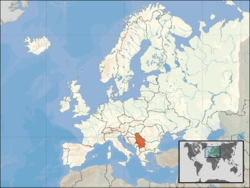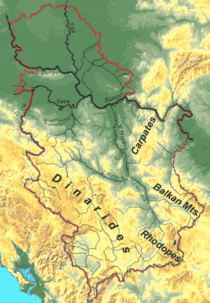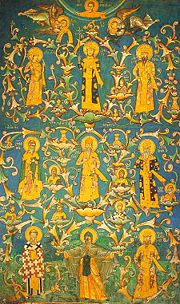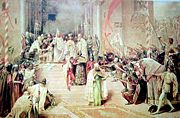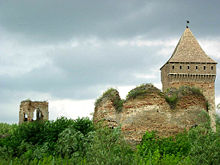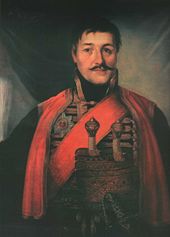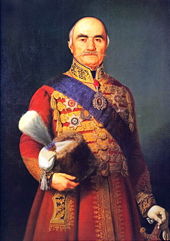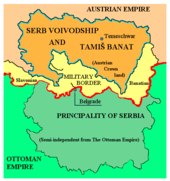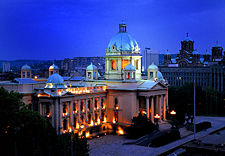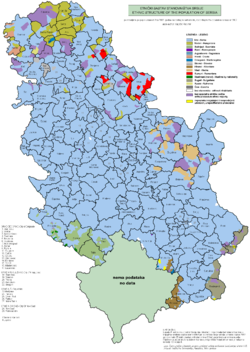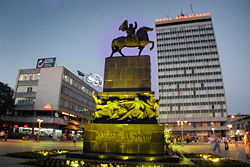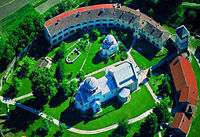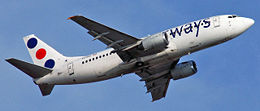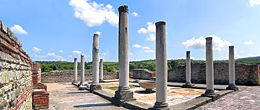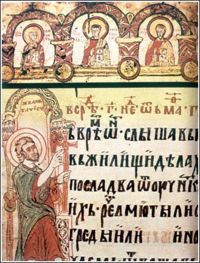Serbia
2008/9 Schools Wikipedia Selection. Related subjects: Europe; European Countries
| Република Србија Republika Srbija Republic of Serbia
|
||||||
|---|---|---|---|---|---|---|
|
||||||
| Anthem: Боже правде / Bože pravde "Lord Give Us Justice" |
||||||
|
Location of Serbia (orange)
on the European continent (white) — [ Legend] |
||||||
| Capital (and largest city) |
Belgrade |
|||||
| Official languages | Serbian | |||||
| Recognised regional languages | Hungarian, Slovak, Romanian, Croatian, Rusyn 1 Albanian 2 |
|||||
| Demonym | Serbian | |||||
| Government | Parliamentary Democracy | |||||
| - | President | Boris Tadić | ||||
| - | Prime Minister | Mirko Cvetković | ||||
| - | President of Parliament | Slavica Đukić Dejanović | ||||
| - | Supreme Court President | Vida Petrović-Škero | ||||
| Establishment | ||||||
| - | First state | 7th century | ||||
| - | Serbian Empire | 1345 | ||||
| - | Independence lost | 1540 | ||||
| - | First Serbian Uprising5(Modern Statehood) | February 15, 1804 | ||||
| - | De facto independence | 25 March 1867 | ||||
| - | De jure independence | 13 July 1878 | ||||
| - | Unification | 25 November 1918 | ||||
| - | Republic of Serbia | 6 June 2006 | ||||
| Area | ||||||
| - | Total | 88 361 km² ( 113th) 34 116 sq mi |
||||
| - | Water (%) | 0.13 | ||||
| Population | ||||||
| - | 2008 estimate | 10,159,046 | ||||
| - | 2002 census | 7,498,0006 | ||||
| - | Density | 115/km² ( 94th) 297/sq mi |
||||
| GDP ( PPP) | 2008 estimate | |||||
| - | Total | $81.982 billion (IMF) | ||||
| - | Per capita | $10 985 | ||||
| Gini (2007) | .24 (low) | |||||
| Currency | Serbian dinar7 ( RSD) |
|||||
| Time zone | CET ( UTC+1) | |||||
| - | Summer ( DST) | CEST ( UTC+2) | ||||
| Internet TLD | .rs ( .yu)8 | |||||
| Calling code | +381 | |||||
| 1 All spoken in Vojvodina. 2 Spoken in Kosovo. 3 Raška, preceded by Kingdom of Duklja (1077) 4To the Ottoman Empire and Kingdom of Hungary 5 The Proclamation (of independence, 1809) 6 excluding Kosovo 7 The Euro is used in Kosovo alongside the Dinar. 8 .rs became active in September 2007. Suffix .yu will exist until September 2009. |
||||||
Serbia ( Serbian: Србија, Srbija), officially the Republic of Serbia ( Serbian: Република Србија, Republika Srbija, listen ), is a landlocked country in Central and Southeastern Europe, covering the southern part of the Pannonian Plain and the central part of the Balkan Peninsula. Serbia is bordered by Hungary to the north; Romania and Bulgaria to the east; the Republic of Macedonia and Albania to the south; and Croatia, Bosnia and Herzegovina and Montenegro to the west. The capital is Belgrade.
For centuries, located at, and shaped by, the cultural boundaries between the East and the West, a powerful medieval kingdom – later renamed the Serbian Empire – occupied much of the Balkans. Torn by domestic feuds, Ottoman-, Hungarian- and later, Austrian incursions, the Serbian state collapsed by the mid-16th century. The success of the Serbian revolution in 1817 marked the birth of modern Serbia. Within a century it reacquired Kosovo, Raška and Vardar Macedonia from the Ottoman Empire. Likewise, in 1918 the former autonomous Habsburg crownland of Vojvodina proclaimed its secession from Austria-Hungary to unite with the Serbia, preceded by the Syrmia region.
The current borders of the country were established afterWorld War II, when Serbia became a federal unit within the Socialist Federal Republic of Yugoslavia. Serbia became an independent state again in 2006, after Montenegro left the union that formed after the dissolution of Yugoslavia in 1990s.
In February 2008, the parliament of Kosovo unilaterally declared independence from Serbia. Serbia's government, as well as the UN Security Council, have not recognized Kosovo's independence. The response from the international community has been mixed. Serbia is a member of the United Nations, the Organization for Security and Co-operation in Europe, and the Council of Europe, and is an associate member of the European Union.
Geography
Serbia is at the crossroads between Central, Southern and Eastern Europe, between the Balkan peninsula and the Pannonian plain. The country is intersected by several major navigable rivers: the Danube (2850km), Sava (945 km), Tisa (1358km), joined by the Timiş River (350 km) and Begej (254 km), all of which connect Serbia with Northern and Western Europe (through the Rhine-Main-Danube Canal – North Sea route), to Eastern Europe (via the Tisa–, Timiş–, Begej – and Danube – Black sea routes) and to Southern Europe (via the Sava river). Two largest Serbian cities- Belgrade and Novi Sad- are major regional Danubian harbours.
The northern third of the country is located entirely within the Central European Pannonian plain. The easternmost tip of Serbia extends into the Wallachian Plain. The north eastern border of the country is determined by the Carpathian Mountain range, which runs through the whole of Central Europe. The Southern Carpathians meet the Balkan Mountains, following the course of the Velika Morava, a 500 km long (partially navigable) river. The Midžor peak is the highest point in eastern Serbia at 2156 m. In the southeast, the Balkan Mountains meet the Rhodope Mountains, connecting the country with Greece. The Šar Mountain of Kosovo form the border with Albania, with one of the highest peaks in the region, Djeravica (2656 m). Dinaric Alps of Serbia follow the flow of the Drina river (at 350 km navigable for smaller vessels only) overlooking the Dinaric peaks on the opposite shore in Bosnia and Herzegovina.
Over a quarter of Serbia's overall landmass (27%) is covered by forest.
Climate
The Serbian climate varies between a continental climate in the north, with cold winters, and hot, humid summers with well distributed rainfall patterns, and a more Adriatic climate in the south with hot, dry summers and autumns and relatively cold winters with heavy inland snowfall. Differences in elevation, proximity to the Adriatic sea and large river basins, as well as exposure to the winds account for climate differences. Vojvodina possesses typical continental climate, with air masses from Northern and Western Europe which shape its climatic profile. South and South-west Serbia is subject to Mediterranean influences. However the Dinaric Alps and other mountain ranges contribute to the cooling down of most of the warm air masses. Winters are quite harsh in Sandžak because of the mountains which encircle the plateau.
The verage annual air temperature for the period 1961–90 for the area with an altitude of up to 300m is 10.9 °C. The areas with an altitude of 300m to 500m have an average annual temperature of around 10.0 °C, and over 1000 m of altitude around 6.0 °C.
National parks
Serbia has 5 national parks:
- Fruška Gora (250 km²)
- Kopaonik (120 km²)
- Tara (220 km²)
- Đerdap (640 km²)
- Šar Mountains (390 km²)
History
Early history
Serbia's strategic location between two continents has subjected it to invasions by many peoples. Belgrade is believed to have been razed to the ground by 40 different armies in recorded history. Contemporary Serbia comprises the classical regions of Moesia, Pannonia, parts of Dalmatia, Dacia and Macedonia. Under nominal Serbian rule since the 7th century (having been allowed to settle in Byzantium by its emperor Heraclius after their victory over the Avars), through early history various parts of the territory of modern Serbia have been colonized, claimed or ruled by: the Greeks and Romans (conquered the indigenous Celts and Illyrians); the Western- and the Eastern Roman Empires (challenged by the incursions of the Huns, the Ostrogoths, the Gepidae, the Sarmatians, the Avars, the Serbs, the Frankish Kingdom, the Great Moravia, the Bulgarians). No less than 17 Roman Emperors were born in the land that is now Serbia.
Medieval Serb kingdoms and the Serbian Empire
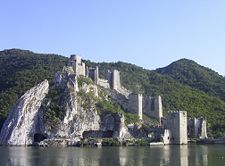
Serbs formed their first unified state under the Vlastimirovic dynasty by 812, at times disrupted by the wars with the aforementioned states. By the beginning of the 14th century Serbs lived in four distinctly independent kingdoms- Dioclea, Rascia, Bosnia and Syrmia.
At first heavily dependent on the Byzantine Empire, to which it rendered tribute, in time the most powerful of the Serb states - Raška (Rascia) achieved full independence, overtaking the Kingdom of Duklja, which had previously dominated the Serbian lands between 11-12th centuries. The centre of the Serb world (Raska, Duklja, Travunia, Zahumlje, Pagania and Bosnia) moved northwards, further from the Adriatic coast. Although fully converted to Christianity as early as 865 AD, this relocation to the north and east also meant a shift towards the Eastern Orthodox rather than the Catholic faith (initially predominant in the south following the East-West Schism).
The Serbian apogee in economy, law, military matters, and religion was reached during the rule of the House of Nemanjić between 1166 and 1371; the Serbian Kingdom was proclaimed in 1217, joined later by the Kingdom of Syrmia, Banovina of Mačva and Bosnia; finally, the Serbian Empire of Stefan Dušan was formed in 1346. Under Dušan's rule, Serbia reached its territorial peak, becoming one of the larger states in Europe. The renowned Dušan's Code, a universal system of laws, was enforced.
As a result of internal struggle between rival noble families, and heavy losses inflicted by the Ottomans in the epic Battle of Kosovo, the Serbian Empire had dissolved into many statelets by the beginning of the 15th century. Throughout the 15th and 16th centuries, constant struggles took place between various Serbian kingdoms on the one hand, and the Ottoman Empire on the other. The Serbian Despotate fell in 1459 following the siege of the "temporary" capital Smederevo, followed by Bosnia a few years later, and Herzegovina in 1482. Montenegro was overrun by 1499. Belgrade was the last major Balkan city to endure Ottoman onslaughts, when it joined the Catholic Kingdom of Hungary. Serbs, Hungarians and European crusaders heavily defeated the Turkish in the Siege of Belgrade of 1456. Several Serbian despots ruled in parts of Vojvodina as vassals of the Hungarian kings with the title of Hungarian barons. After repelling Ottoman attacks for over 70 years, Belgrade finally fell in 1521, along with the greater part of the Kingdom of Hungary. Conversion to Islam was increased, especially in the southwest ( Raška, Kosovo and Bosnia).
Ottoman and Austrian rule
The Early modern period saw the loss of Serbia's independence to the Kingdom of Hungary and the Ottoman Empire, interrupted briefly by the revolutionary state of the Emperor Jovan Nenad in the 16th century. Modern times witnessed the rise of the Habsburg Monarchy (known as the Austrian Empire, later Austria-Hungary), which fought many wars against the Ottoman Turks for supremacy over Serbia. Three Austrian invasions and numerous rebellions (such as the Banat Uprising) constantly challenged Ottoman rule. Vojvodina endured a century long Ottoman occupation before being ceded to the Habsburg Empire in the 17th-18th centuries under the terms of the Treaty of Karlowitz (Sremski Karlovci). As the Great Serb Migrations depopulated most of Kosovo and Serbia proper, the Serbs sought refuge in more prosperous (and Christian) North and West were granted imperial rights by the Austrian crown (under measures such as the Statuta Wallachorum in 1630). The Ottoman persecutions of Christians culminated in the abolition and plunder of the Patriarchate of Peć in 1766. As Ottoman rule in the South grew ever more brutal, the Holy Roman Emperor Leopold I formally granted the Serbs the right to their autonomous crown land, speeding up their migrations into Austria.
The Serbian Revolution and independence (Principality of Serbia)
The quest for independence of Serbia began during the Serbian national revolution (1804-1817), and it lasted for several decades. During the First Serbian Uprising led by Karađorđe Petrović, Serbia was independent for almost a decade before the Ottoman army was able to reoccupy the country. Shortly after this, the Second Serbian Uprising began. Led by Miloš Obrenović, it ended in 1815 with a compromise between the Serbian revolutionary army and the Ottoman authorities. The famous German historian Leopold von Ranke published his book "The Serbian revolution" (1829). They were the easternmost bourgeois revolutions in the 19th-century world. Likewise, Principality of Serbia abolished feudalism- second in Europe after France.
The Convention of Ackerman (1828), the Treaty of Adrianople (1829) and finally, the Hatt-i Sharif of 1830, recognised the suzerainty of Serbia with Miloš Obrenović I as its hereditary Prince. The struggle for liberty, a more modern society and a nation-state in Serbia won a victory under first constitution in the Balkans on 15 February 1835. It was replaced by a more conservative Constitution in 1838.
In the two following decades (temporarily ruled by the Karadjordjevic dynasty) the Principality actively supported the neighbouring Habsburg Serbs, especially during the 1848 revolutions. Interior minister Ilija Garašanin published The Draft (for South Slavic unification), which became the standpoint of Serbian foreign policy from the mid-19th century onwards. The government thus developed close ties with the Illyrian movement in Croatia-Slavonia (Austria-Hungary).
Following the clashes between the Ottoman army and civilians in Belgrade in 1862, and under pressure from the Great Powers, by 1867 the last Turkish soldiers left the Principality. By enacting a new constitution without consulting the Porte, Serbian diplomats confirmed the de facto independence of the country. In 1876, Montenegro and Serbia declared war on the Ottoman Empire, proclaiming their unification with Bosnia. The formal independence of the country was internationally recognized at the Congress of Berlin in 1878, which formally ended the Russo-Turkish War of 1877-78; this treaty, however, prohibited Serbia from uniting with Principality of Montenegro, and placed Bosnia and Raška region under Austro-Hungarian occupation to prevent unification.
Kingdom of Serbia
From 1815 to 1903, Serbia was ruled by the House of Obrenović (except from 1842 to 1858, when it was led by Prince Aleksandar Karađorđević). In 1882, Serbia, ruled by King Milan, was proclaimed a Kingdom. In 1903, the House of Karađorđević, (descendants of the revolutionary leader Đorđe Petrović) assumed power. Serbia was the only country in the region that was allowed by the Great Powers to be ruled its own domestic dynasty. During the Balkan Wars (1912-1913), the Kingdom of Serbia tripled its territory by acquiring part of Macedonia, Kosovo, and parts of Serbia proper.
As for Vojvodina, during the 1848 revolution in Austria, Serbs of Vojvodina with the help of Croatia-Slavonia established an autonomous region known as Serbian Vojvodina. As of 1849, the region was transformed into a new Austrian crown land known as the Serbian Voivodship and Tamiš Banat. Although abolished in 1860, Habsburg emperors claimed the title Großwoiwode der Woiwodschaft Serbien until the end of the monarchy and the creation of Kingdom of Serbs, Croats and Slovenes in 1918.
World War I and the birth of Yugoslavia
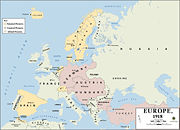
On June 28, 1914 the assassination of Archduke Franz Ferdinand of Austria at Sarajevo in Bosnia-Herzegovina by Gavrilo Princip (a South Slav unionist, Austrian citizen and member of Young Bosnia) led to Austria-Hungary declaring war on Kingdom of Serbia. In defense of its ally Serbia the Russian Empire started to mobilize its troops , which resulted in the German Empire declaring war on Russia (in support of Austria-Hungary). The retaliation by Austria-Hungary against Serbia activated a series of military alliances that set off a chain reaction of war declarations across the continent, leading to the outbreak of World War I within a month.
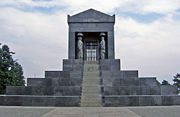
The Serbian Army won several major victories against Austria-Hungary at the beginning of World War I, such as the Battle of Cer and Battle of Kolubara - marking the first Allied victories against the Central Powers in WWI. Despite initial success it was eventually overpowered by the joint forces of the German Empire, Austria-Hungary and Bulgaria in 1915. Most of its army and some people went into exile to Greece and Corfu where they recovered, regrouped and returned to Macedonian front (World War I) to lead a final breakthrough through enemy lines on September 15, 1918, freeing Serbia again and defeating Austro-Hungarian Empire and Bulgaria. Serbia (with its major campaign) was a major Balkan Entente Power which contributed significantly to the Allied victory in the Balkans in November 1918. The country was militarilly classified as a minor Entente power.
Casualties
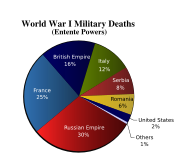
Prior to the war, the Kingdom of Serbia had 4.5 million inhabitants. According to the New York Times, in 1915 alone 150,000 people are estimated to have died during the worst typhus epidemics in world history. With the aid of the American Red Cross and 44 foreign governments, the outbreak was brought under control by the end of the year. According to FirstWorldWar.com, the number of civilian deaths is estimated at 650,000, primarily due to the typhus outbreak and famine, but also direct clashes with the occupiers. Kingdom of Serbia ranked first among the Entente powers by the percentage of military deaths; 8% of the total Entente military deaths or 58% of the Serbian Army (420,000 strong) has perished during the conflict. The total number of casualties ranges anywhere between 700,000 and 900,000- over 20% of Serbia's prewar size, and over ⅓ of its male population. L.A.Times and N.Y.Times placed the figure at over one million in their respective articles.
The extent of the Serbian demographic disaster can be illustrated by the statement of the Bulgarian Prime Minister Vasil Radoslavov: "Serbia ceased to exist" (New York Times, summer 1917). In July 1918 the US Secretary of State Robert Lansing urged the Americans of all religions to pray for Serbia in their respective churches.
Kingdom of Yugoslavia ("First Yugoslavia")
- Syrmia region was the first among former Habsburg lands to declare union with the Kingdom of Serbia on November 24, 1918.
- Banat, Bačka and Baranja- ( Vojvodina)- joined the Kingdom on the next day.
- On November 26, 1918, the Kingdom of Montenegro declared its unification with the Kingdom of Serbia.
- Bosnia and Herzegovina announces the unification with Serbia after a referendum
- On December 1, 1918, the State of Slovenes, Croats and Serbs and the Kingdom of Serbia joined the unitary Kingdom of Serbs, Croats and Slovenes (later Kingdom of Yugoslavia). King Peter I of Serbia became King Peter I of Yugoslavia.
- Bosnia and Herzegovina announces the unification with Serbia after a referendum
- On November 26, 1918, the Kingdom of Montenegro declared its unification with the Kingdom of Serbia.
World War II
Invasion of Yugoslavia
The Kingdom of Yugoslavia was in a precarious position in World War II. Fearing an invasion by Nazi Germany, the Yugoslav Regent, Prince Paul, signed the Tripartite Pact with the Axis powers on 25 March 1941, triggering massive demonstrations in Belgrade. On March 27, Prince Paul was overthrown by a military coup d'état (with British support) and replaced by the 17-year-old King Peter II. General Dušan Simović became Peter's Prime Minister and the Kingdom of Yugoslavia withdrew its support for the Axis.
In response to this Adolf Hitler launched an invasion of Yugoslavia on April 6. By April 17, unconditional surrender was signed in Belgrade. After the invasion, the Kingdom of Yugoslavia was dissolved and, with Yugoslavia partitioned, the remaining portion of Serbia became part of the Military Administration of Serbia, under a joint German-Serb government, with military power controlled by the German armed forces, while a Serb civil government led by Milan Nedić was permitted to try to draw Serbs away from their opposition to the Axis occupation of Yugoslavia.
Not all of what is present-day Serbia was included as part of the military administration. Some of the contemporary Republic of Serbia was occupied by the Kingdom of Croatia, the Kingdom of Hungary, the Kingdom of Bulgaria, the Fascist Italy's Balkan protectorates, the Albanian Kingdom and the Kingdom of Montenegro. In addition to being occupied by the ( Wehrmacht), from 1941 to 1945, Serbia was the scene of a civil war between Royalist Chetniks commanded by Draža Mihailović and Communist Partisans commanded by Josip Broz Tito. Against these forces were arrayed Nedić's units of the Serbian Volunteer Corps and Serbian State Guard.
Genocide of Serbs by the Ustase regime in Croatia
Serbia's society was profoundly affected by the events that took place in the neighboring Independent State of Croatia (Nezavisna Država Hrvatska, NDH) during World War II. Serbs, Jews, and Roma in the neighboring Independent State of Croatia (Nezavisna Država Hrvatska, NDH) were subjected to large-scale persecution and killings, particularly in the Jasenovac concentration camp. The stimated number of Serbian children who died is between 35,000 and 50,000. United States Holocaust Encyclopedia and Jewish Virtual Library estimate that there were between Serb victims in Jasenovac and between 330,000 and {{formatnum:390000} . The Yad Vashem centre reports that over 500,000 Serbs were killed overall in the NDH., with some 600,000 people of many nationalities and ethnicities murdered in one camp Jasenovac. After the war, official Yugoslav sources estimated over 700,000 victims, mostly Serbs. Misha Glenny suggests that the numbers of Serbs killed in the genocide was more than 400,000.
The atrocities that took place in Croatia against Serbs has led to a deep sense of antagonism by Serbs towards Croats, which a number of governments have attempted to lessen. Reconciliation between the two peoples was attempted under Joseph Broz Tito's policy of Brotherhood and Unity, but this was destroyed with the outbreak of the Yugoslav wars in the 1990s. The most recent attempt was made at the commemoration to the Serb casualties of the Jasenovic concentration camp in April 2003, when the Croatian president Stjepan Mesic apologized to the victims of Jasenovac. In 2006, on the same occasion, he added that to every visitor to Jasenovac it must be clear that the "Holocaust, genocide and war crimes" took place there.
Socialist Yugoslavia ("Second Yugoslavia")
On November 29, 1945, the constitutional assembly established by the Yugoslav Communist party proclaimed the abolition of the Serbian-led monarchy of Yugoslavia. - and the royal family banned from returning to the country. A communist regime was established under a dictatorship led by Yugoslav Communist leader Joseph Broz Tito. Serbia was one of 6 federal units of the state, the Socialist Federal Republic of Yugoslavia ( Socijalistička Federativna Republika Jugoslavija, or SFRJ). Serbia was controversially internally divided with the creation of the autonomous provinces of Kosovo and Vojvodina, in which the Serbian parliament held no control over the political affairs of the two provinces, and technically only held power over Central Serbia. The action was taken due to pressure on the communist regime by the other republics, which claimed that Yugoslavia's political structure was subject to Serb hegemony. Many Serbs, including those in the Yugoslav Communist party, resented the powers held by the autonomous provinces. At the same time, a number of Kosovo Albanians in the 1980s began to demand that Kosovo be granted the right to be a republic within Yugoslavia, thus giving it the right to separate, a right which it did not have as an autonomous province. The ethnic tensions between Serbs and Albanians in Kosovo would eventually have a major influence in the collapse of the SFRY.
Collapse of Communist Yugoslavia
In 1989, the League of Communists of Serbia selected Slobodan Milošević to become the President of Serbia. Milošević was controversial in Yugoslavia because he opposed Kosovo's autonomy and because his rise to power through the Anti-bureaucratic revolution was achieved through mass protests, which pushed out the leadership of the autonomous provinces and also the republic of Montenegro which installed politicians allied to Milošević. Milošević also aggravated the situation in post-Tito Yugoslavia by alleging that certain politicians in Yugoslavia were anti-Serb. His pressure to change the constitution to limit Kosovo's autonomy and bring in a one-member-one-vote system in the Yugoslav League of Communists congress (thus giving a numerical majority to the Serbs) worsened relations in the League of Communists, which broke up along republican lines. Slovenia, Croatia, Macedonia, and Bosnia and Herzegovina all elected governments which supported secession from Yugoslavia and referendums on independence resulted in majorities supporting independence in those republics. The only remaining political leadership willing to govern the SFRY was made up of Serbian and Montenegrin politicians. The federal leadership from 1991 to 1992 was heavily influenced by the Serbian President Milošević who led the SFRY's largest of the two republics still committed to union.
Federation of Serbia and Montenegro ("Third Yugoslavia") and the Kosovo War
By 1992, Slovenia, Croatia, Macedonia, and Bosnia and Herzegovina had all declared independence from Yugoslavia, resulting in the collapse of the SFRJ and the outbreak of war. In response, Serbia and Montenegro formed the Federal Republic of Yugoslavia (Savezna Republika Jugoslavija, or SRJ). The Serbian government initially supported the Serbs of Croatia and the Bosnian Serbs in the Yugoslav wars fought from 1991 to 1995. This period of political turmoil marked a rise in ethnic tensions and xenophobia between Serbs and other ethnicities of the former Communist Yugoslavia as most of the other ethnicities demanded independence while Serbs saw the secessions as tearing apart the Serb nation which had a heavy populace in Bosnia & Herzegovina and Croatia. Sanctions were imposed by the United Nations, which led to political isolation and economic decline of the SRJ.
In 1995, the Dayton Agreement was signed in Paris, France. This agreement ended the war in Bosnia and Herzegovina and the war in Croatia. For the time being, the SRJ was officially at peace.
Between 1998 and 1999, Serbia's official peace was broken when the situation in Kosovo worsened with continued clashes in Kosovo between the Serbian and Yugoslavian security forces on one side and the ethnic Albanian Kosovo Liberation Army (KLA) on the other. What became known as the Kosovo War prompted " Operation Allied Force." This operation included aerial bombardment of Serbia by forces of the North Atlantic Treaty Organization (NATO). The bombings lasted for 78 days. The bombings were ended following negotiations on the border between the Republic of Macedonia and the SRJ. The negotiations were held between NATO spokesperson Mike Jackson and SRJ officials speaking on behalf of Milošević. It was agreed that Milošević would order the withdrawal of all SRJ security forces, including the military and the police, and agree to have them replaced by a body of international police. The agreement upheld Yugoslavian (later Serbian) sovereignty over Kosovo but replaced Serbian government of the province with a UN administration, the United Nations Interim Administration Mission in Kosovo ( UNMIK). NATO also agreed to end its demand to station NATO troops across the whole of the SRJ. This had been one of its demands at the Rambouillet negotiations prior to the bombing campaign.
Democratic transition
In September 2000, opposition parties claimed that Milošević committed fraud in routine federal elections. Street protests and rallies throughout Serbia eventually forced Milošević to concede and hand over power to the recently formed Democratic Opposition of Serbia (Demokratska opozicija Srbije, or DOS). The DOS was a broad coalition of anti-Milošević parties. On 5 October, the fall of Milošević led to end of the international isolation Serbia suffered during the Milošević years. Serbia's new leaders announced that Serbia would seek to join the European Union (EU). In October 2005, the EU opened negotiations with Serbia for a Stabilization and Association Agreement (SAA), a preliminary step towards joining the EU.
From 2003 to 2006, Serbia has been part of the "State Union of Serbia and Montenegro." This union was the successor to the Federal Republic of Yugoslavia (SRJ).
On May 21, 2006, Montenegro held a referendum to determine whether or not to end its union with Serbia. The next day, state-certified results showed 55.4% of voters in favour of independence. This was just above the 55% required by the referendum.
Republic of Serbia
On June 5, 2006, following the referendum in Montenegro, the National Assembly of Serbia declared the "Republic of Serbia" to be the legal successor to the "State Union of Serbia and Montenegro." Serbia and Montenegro became separate nations. However, the possibility of a dual citizenship for the Serbs of Montenegro is a matter of the ongoing negotiations between the two governments. In April 2008 Serbia was invited to join the intensified dialogue programme with NATO despite the diplomatic rift with the Alliance over Kosovo.
Government and politics
On February 4, 2003 the parliament of the Federal Republic of Yugoslavia agreed to a weaker form of cooperation between Serbia and Montenegro within a confederal state called Serbia and Montenegro. The Union ceased to exist following Montenegrin and Serbian declarations of independence in June 2006.
After the ousting of Slobodan Milošević on October 5, 2000, the country was governed by the Democratic Opposition of Serbia. Tensions gradually increased within the coalition until the Democratic Party of Serbia (DSS) left the government, leaving the Democratic Party (DS) in overall control.
Serbia held a two-day referendum on October 28 and October 29, 2006, that ratified a new constitution to replace the Milošević-era constitution.
The current President of Serbia is Boris Tadić, leader of the centre-left Democratic Party (DS). He was reelected with 50,5% of the vote in the second round of the Serbian presidential election held on February 4, 2008.
Serbia held Parliamentary elections on January 21, 2007. The right-wing Serbian Radical Party claimed victory, but no party has won an absolute majority. Following last-minute negotiations on the part of the DS and DSS political parties, an agreement was reached on the make-up of the country's new government on 11 May 2007 between DS, DSS and G17 Plus.
On March 13, 2008 the Serbian government collapsed when "President Boris Tadic dissolved parliament Thursday and called early elections for May 11" citing the growing rift between himself and nationalist Prime Minister Vojislav Kostunica over membership in the EU and Kosovo's Independence. The government's collapse came less than a month after ethnic Albanian majority Kosovo unilaterally proclaimed independence from Serbia, which considers the territory its historic heartland.
Administrative subdivisions
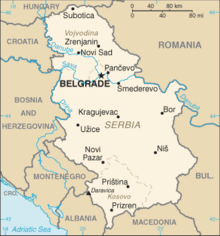
Serbia is divided into 24 districts plus the City of Belgrade. The districts and the City of Belgrade are further divided into municipalities. Serbia has 2 autonomous provinces: Vojvodina with (7 districts, 46 municipalities) and Kosovo and Metohija. Kosovo has declared independence but is still presently under the administration of the United Nations Interim Administration Mission in Kosovo; international negotiations began in 2006 to determine its final status (See Kosovo status process); Kosovo declared its independence on February 17, 2008, which Belgrade opposes.
The part of Serbia that is neither in Kosovo nor in Vojvodina is called Central Serbia. Central Serbia is not an administrative division, unlike the two autonomous provinces, and it has no regional government of its own. In English this region is often called " Serbia proper" to denote "the part of the Republic of Serbia not including the provinces of Vojvodina and Kosovo", as the Library of Congress puts it. This usage was also employed in Serbo-Croatian during the Yugoslav era (in the form of "uža Srbija", literally: "narrow Serbia"). Its use in English is purely geographical, without any particular political meaning being implied.
Demographics
- Serbia (Census 2002, excluding Kosovo): 7,498,001
- Central Serbia: 5,466,009
- Vojvodina: 2,031,922
| Serbia (excluding Kosovo) in 2002 | ||||
|---|---|---|---|---|
| Serbs | 82.86% | |||
| Hungarians | 3.91% | |||
| Bosniaks | 1.82% | |||
| Roma | 1.44% | |||
| Yugoslavs | 1.08% | |||
| Other | 9.79% | |||
Serbia is populated mostly by Serbs. Significant minorities include Hungarians, Bosniaks, Roma, Croats, Czechs and Slovaks, Montenegrins, Macedonians, Bulgarians, Romanians, etc. The northern province of Vojvodina is ethnically and religiously diverse.
According to the last official census data collected in 2002, ethnic composition of Serbia is:
- Total: 7,498,001
- Serbs: 6,212,000 (82.86%)
- Hungarians: 293,172 (3.91%)
- Bosniaks: 136,464 (1.82%)
- Roma: 107,971 (1.44%)
- Yugoslavs: 80,978 (1.08%)
- Croats: 70,602 (0.94%)
- Slovaks: 57,900 (0.89%)
- Others (each less than 1%): 474,323 (6.33%)
According to the poll conducted on January 1, 2006 by the Yugoslav Survey Society Serbia had 7,395,600 inhabitants - a 1.5% decrease comparing to the 2002 Census.
The census was not conducted in Serbia's southern province of Kosovo, which is under administration by the United Nations. According to the EU estimates however, the overall population is estimated at 1,350,000 inhabitants, of whom 90% are Albanians, 8% Serbs and others 2%.There are also around 200,000 Serbian and other refugees,who are expelled from Kosovo. Refugees and IDPs in Serbia form between 7% and 7.5% of its population – about half a million refugees sought refuge in the country following the series of Yugoslav wars (from Croatia mainly, to an extent Bosnia and Herzegovina too and the IDPs from Kosovo, which are the most numerous at over 200,000) Serbia has the largest refugee population in Europe.
- Cities
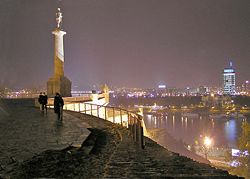
Officially recognized cities (over 100,000 on municipal level) — 2002 census data (2005/2006 data for Novi Sad/Belgrade).
| City | Population | |
|---|---|---|
| Urban | Metropolitan | |
| Belgrade | 1,576,124 | 1,689,667 |
| Novi Sad | 255,071 | 333,895 |
| Niš | 236,722 | 252,131 |
| Kragujevac | 175,473 | 211,580 |
| Subotica | 99,471 | 147,758 |
| Zrenjanin | 79,545 | 131,509 |
| Leskovac | 78,030 | 156,252 |
| Smederevo | 77,808 | 109,867 |
| Pančevo | 77,087 | 127,162 |
| Kruševac | 75,256 | 131,368 |
| Čačak | 73,217 | 117,012 |
| Užice | 63,577 | 83,022 |
| Valjevo | 61,035 | 96,761 |
| Kraljevo | 57,411 | 121,707 |
| Šabac | 55,240 | 122,893 |
| Vranje | 55,052 | 87,288 |
| Novi Pazar | 54,604 | 85,249 |
| Sombor | 51,471 | 97,263 |
| Sremska Mitrovica | 39,041 | 85,605 |
- Large cities in the contested province of Kosovo and Metohija like Priština, Prizren, Peć and Kosovska Mitrovica were not subjected to the 2002 Census.
Religion
| Serbia (excluding Kosovo) in 2002 | ||||
|---|---|---|---|---|
| religion | percent | |||
| Eastern Orthodoxy | 84.1% | |||
| Roman Catholicism | 6.24% | |||
| Islam | 4.82% | |||
| Protestantism | 1.44% | |||
For centuries straddling the religious boundary between Orthodoxy and Roman Catholicism, joined up later by the penetration of Islam, Serbia remains one of the most diverse countries on the continent. Centuries on, different regions of Serbia remain heavily cosmopolitan: Kosovo province houses a 90% Muslim community, Vojvodina province is 25% Catholic or Protestant, while Central Serbia and Belgrade regions are over 90% Orthodox Christian.
Among the Eastern Orthodox churches, the Serbian Orthodox Church is the westernmost. According to the 2002 Census, 82% of the population of Serbia (excluding Kosovo) or 6,2 million people declared their nationality as Serbian, who are overwhelmingly adherents of the Serbian Orthodox Church. Other Orthodox Christian communities in Serbia include Montenegrins, Romanians, Macedonians, Bulgarians, Vlachs etc. Together they comprise about 84% of the entire population.
Catholicism is mostly present in Vojvodina (mainly in its northern part), where almost 20% of the regional population (minority ethnic groups such as the Hungarians, Slovaks, Croats, Bunjevci, Czechs etc. belong to this Christian denomination. There are an estimated 433,000 baptized Catholics in Serbia, roughly 6,2% of the population, mostly in the northern province.
Protestantism accounts for about 1.5 % of the country's population.
Islam has a strong historic following in the southern regions of Serbia - Raska and several municipalities in the south-east. Bosniaks are the largest Muslim community in Serbia at about 140,000 (2%), followed by Albanians (1%), Turks, Arabs etc.
With the exile of Jews from Spain during the infamous Inquisition era, thousands of escaping families and individuals made their way through Europe to the Balkans. A goodly number settled in Serbia and became part of the general population. They were well accepted and during the ensuing generations the majority assimilated or became traditional or secular, rather than remain orthodox Jews as had been the original immigrants. Later on the wars that ravaged the region resulted in a great part of the Serbian Jewish population either being killed or escaping to Yugoslavia and Austria-Hungary.
Economy
With a GDP for 2008 estimated at $81.892 billion ($10,985 per capita PPP), Republic of Serbia is considered an upper-middle income economy by the World Bank. FDI (Foreign Direct Investment) in 2006 was $5.85 billion or €4.5 billion. FDI for 2007 reached $4.2 Billion while real GDP per capita figures are estimated to have reached $6 600 (October 2007). The GDP growth rate showed increase by 6.3% (2005), 5.8% (2006), reaching 7.5% in 2007 as the fastest growing economy in the region.
At the beginning of the process of economic transition (1989), its favorable economic outlook in the region was hampered by politics, its economy being gravely impacted by the UN economic sanctions of 1992–95, as well as the sizable infrastructure and industry damage, suffered during the Kosovo war. Its problems were only augmented by losing the ex-Yugoslavia and Comecon markets. After the ousting of former Federal Yugoslav President Milošević in October 2000, the country experienced faster economic growth, and has been preparing for membership in the European Union, its most important trading partner.
The recovery of the economy still faces many problems, among which unemployment (18.1%) high export/import trade deficit and considerable national debt are most prominent. The country expects some major economic impulses and high growth rates in the next years. Serbia has been occasionally called a "Balkan tiger" because of its recent high economic growth rates, which averaged 6.6 % (in the past three years), with FDI at its record levels.
Serbia grows about one-third of the world's raspberries and is the leading frozen fruit exporter.
Infrastructure
Communications
89% of households in Serbia have fixed telephone lines, and 90% of the population have cell phones, accounting to 8 million users ( Telekom Srbija – 5 million, Telenor and Vip mobile sharing the rest). 49% of households have computers, 27% use the internet, and 42% have cable TV.
Transportation
Serbia is proud of the fact that it owns one of the world's oldest airline carriers, the Jat Airways, founded in 1927. There are 3 international airports in Serbia: Belgrade Nikola Tesla Airport, Niš Constantine the Great Airport and the Vršac international airport.
The country, especially the valley of the Morava, is often described as "the crossroads between East and West", which is one of the primary reasons for its turbulent history. The Morava valley route, which avoids mountainous regions, is by far the easiest way of traveling overland from continental Europe to Greece and Asia Minor. Modern Serbia was the first among its neighbours to acquire railroads- in 1869 the first train arrived to Subotica, then Austria-Hungary (by 1882 route to Belgrade and Nis was completed). The railway system is operated by Serbian Railways.
European routes E65, E70, E75 and E80, as well as the E662, E761, E762, E763, E771, and E851 pass through the country. The E70 westwards from Belgrade and most of the E75 are modern highways of motorway / autobahn standard or close to that. As of 2005, Serbia has 1,481,498 registered cars, 16,042 motorcycles, 9,626 buses, 116,440 trucks, 28,222 special transport vehicles, 126,816 tractors, and 101,465 trailers.
The Danube River, central Europe's connection to the Black Sea, flows through Serbia. Through Danube-Rhine-Mein canal the North Sea is also accessible. Tisza river offers a connection with Eastern Europe while the Sava river connects her to western former yugoslav republics near the Adriatic Sea.
Tourism
Tourism in Serbia is mostly focused on the villages and mountains of the country. The most famous mountain resorts are Zlatibor, Kopaonik, and the Tara. There are also many spas in Serbia, one the biggest of which is Vrnjačka Banja. Other spas include Soko Banja and Niška Banja. There is a significant amount of tourism in the largest cities like Belgrade, Novi Sad and Niš, but also in the rural parts of Serbia like the volcanic wonder of Đavolja varoš, Christian pilgrimage across the country and the cruises along the Danube, Sava or Tisza. There are several popular festivals held in Serbia, such as the EXIT Festival (proclaimed the best European festival by UK Festival Awards 2007 and Yourope, the European Association of the 40 largest festivals in Europe) and the Guča trumpet festival. 2,2 million tourists visited Serbia in 2007, a 15% increase compared to 2006.
Culture
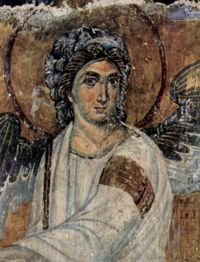
Serbia is one of Europe's most culturally diverse countries. The borders between large empires ran through the territory of today's Serbia for long periods in history: between the Eastern and Western halves of the Roman Empire; between Kingdom of Hungary, Bulgarian Empire, Frankish Kingdom and Byzantium; and between the Ottoman Empire and the Austrian Empire (later Austria-Hungary). As a result, while the north is culturally " Central European", the south is rather more " Oriental". Of course, both regions have influenced each other, and so the distinction between north and south is artificial to some extent.
The Byzantine Empire's influence on Serbia was perhaps the greatest. Serbs are Orthodox Christians with their own national church—the Serbian Orthodox Church. They use both the Cyrillic and Latin alphabets, as a result of both Eastern and Western influences. The monasteries of Serbia, built largely in the Middle Ages, are one of the most valuable and visible traces of medieval Serbia's association with the Byzantium and the Orthodox World, but also with the Romanic (Western) Europe that Serbia had close ties with back in Middle Ages. Most of Serbia's queens still remembered today in Serbian history were of foreign origin, including Hélène d'Anjou (a cousin of Charles I of Sicily), Anna Dondolo (daughter of the Doge of Venice, Enrico Dandolo), Catherine of Hungary, and Symonide of Byzantium.
Serbia has eight cultural sites marked on the UNESCO World Heritage list: Stari Ras and Sopoćani monasteries (included in 1979), Studenica Monastery (1986), the Medieval Serbian Monastic Complex in Kosovo, comprising: Dečani Monastery, Our Lady of Ljeviš, Gračanica and Patriarchate of Pec- (2004, put on the endangered list in 2006), and Gamzigrad - Romuliana, Palace of Galerius, added in 2007. Likewise, there are 2 literary memorials added on the UNESCO's list as a part of the Memory of the World Programme: Miroslav Gospels, handwriting from the 12th century (added in 2005), and Nikola Tesla's archive (2003).
Education
Education in Serbia is regulated by the Ministry of Education. Education starts in either pre-schools or elementary schools. Children enroll in elementary schools ( Serbian: Osnovna škola / Основна школа) at the age of seven, and remain there for eight years.
The roots of the Serbian education system date back to the 11th and 12th centuries when the first Catholic colleges were founded in Vojvodina ( Titel, Bač). Medieval Serbian education, however, was mostly conducted through the Serbian Orthodox monasteries ( Sopocani, Studenica, Patriarchate of Pec) starting from the rise of Raska in 12th century, when Serbs overwhelmingly embraced Orthodoxy rather than Catholicism.
The first university in Serbia was founded in revolutionary Belgrade in 1808 as a Great Academy, the precursor of the contemporary University of Belgrade. The oldest college (faculty) within current borders of Serbia dates back to 1778; founded in the city of Sombor, then Habsburg Empire, it was known under the name Norma and was the oldest Slavic Teacher's college in Southern Europe.
Holidays
All holidays in Serbia are regulated by the Law of national and other holidays in Republic of Serbia (Zakon o državnim i drugim praznicima u Republici Srbiji). The following holidays are observed state-wide:
| Date | Name | Notes |
|---|---|---|
| January 1 / January 2 | New Year's Day (Nova Godina) | non-working holiday |
| January 7 | Orthodox Christmas (Božić) | non-working holiday |
| January 27 | Saint Sava's Day - Spirituality day (Savindan - Dan Duhovnosti) | working holiday (in memory on the founder of the Serbian Orthodox Church) |
| February 15 | Statehood day - Candlemas (Dan državnosti - Sretenje) | non-working holiday (in memory on the First Serbian Uprising) |
| April 25 | Orthodox Great Friday (Veliki petak) | non-working holiday (date for 2008 only) |
| April 26 | Orthodox Great Saturday (Velika subota) | non-working holiday (date for 2008 only) |
| April 27 | Orthodox Easter (Vaskrs) | non-working holiday (date for 2008 only) |
| April 28 | Orthodox Easter Monday (Veliki ponedeljak) | non-working holiday (date for 2008 only) |
| May 1 / May 2 | Labour Day (Dan rada) | non-working holiday |
| May 9 | Victory Day (Dan pobede) | working holiday |
| June 28 | Saint Vitus' Day - Day of the fallen for the fatherland ( Vidovdan - Dan Srba palih za otadžbinu) | working holiday (in memory of the Battle of Kosovo in 1389) |
Also, members of other religions have the right not to work on days of their holidays.


